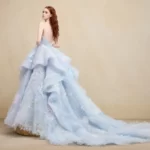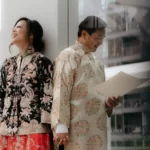 You may have decided that a wedding veil is not your style. Try one on, however, when you’re choosing your gown. You may suddenly feel very bridal.
You may have decided that a wedding veil is not your style. Try one on, however, when you’re choosing your gown. You may suddenly feel very bridal.
The type of veil will depend on the style of your gown, the formality of the wedding and your hair style. The more formal the wedding, the longer the veil may be.
If a gown is structured and in a heavier silk, such as a peau de soie, or brocade, you will want a stiffer veil. On the other hand, a softer veil of lace or chiffon is ideal for a gown of chiffon, georgette or other lightweight fabric. If you have a gown with a long train, there are two options: a short veil or a veil that is several inches longer than the train of the gown.
What you should know about wedding veil
- Flyaway – Covers the face and head. Just to the neck in length.
- Blusher – Short in the front to cover the face, a couple of inches longer at the back.
- Fountain – Double veil not worn over the face, but attached at the top of the head and, in length, covers the shoulders.
- Elbow – Attaches at the top or back of the head, often in two tiers. One tier covers the shoulder, the second goes to the waist.
- Fingertip – To the tip of the fingers when arms are held straight at the sides.
- Floor length – Attaches anywhere on the head and just touches the floor.
- Mantilla – Spanish influence. Edged with lace or other embellishment. From front of the head to longer than the dress.
- Chapel – More than full length. Has a slight trail.
- Cathedral – The most formal of all veils with a sweeping trail.
Final word
If you are planning a garden wedding, avoid trains and long veils because they tend to get caught in the grass!







